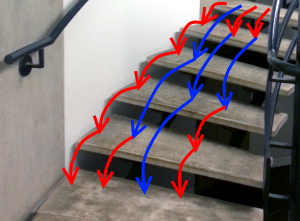Skip over navigation

When I go up my stairs in a hurry, I take some steps two-at-a-time.
Or search by topic
Number and algebra
Geometry and measure
Probability and statistics
Working mathematically
Advanced mathematics
For younger learners
Climbing the Stairs
Age 11 to 16
This resource is part of "Freedom and Constraints"

When I go up my stairs in a hurry, I take some steps two-at-a-time.
This morning, I climbed my thirteen steps in this pattern: 1, 2, 1, 2, 1, 1, 2, 1, 2.
Yesterday the pattern was 1, 1, 1, 1, 1, 1, 2, 2, 1, 2.
How many days do you think I can go before I have to repeat a pattern?
Charlie estimated a lower bound:
I wonder if there's a different pattern of climbing the stairs for each day of the year.
There are lots of possibilities. It's going to be really hard to count them all without missing any, and without accidentally counting any twice.
Sometimes mathematicians like to tackle a big task by starting with a more manageable one, to get some insight into the bigger problem...
Can you think of some more manageable problems you could work on, to help you to get started?
Take a look at the hidden image if you would like a hint:

What other interesting mathematical questions can you think of to explore next?
We have thought of some possibilities:
Yesterday the pattern was 1, 1, 1, 1, 1, 1, 2, 2, 1, 2.
How many days do you think I can go before I have to repeat a pattern?
Charlie estimated a lower bound:
"Even if I only do a 2-step once, I can choose to take that step from any one of 12 places on the staircase. And I could have two, or three, or four 2-steps... so there will be lots more possibilities. It's going to be at least 50."
I wonder if there's a different pattern of climbing the stairs for each day of the year.
There are lots of possibilities. It's going to be really hard to count them all without missing any, and without accidentally counting any twice.
Sometimes mathematicians like to tackle a big task by starting with a more manageable one, to get some insight into the bigger problem...
Can you think of some more manageable problems you could work on, to help you to get started?
Take a look at the hidden image if you would like a hint:

What other interesting mathematical questions can you think of to explore next?
We have thought of some possibilities:
How can you be sure you've included every possibility?
Is there a quick way to work out the number of different ways to go up staircases with many steps?
How can you be sure that your method will work for all staircases, not just the ones you've tried?
How many steps would I need on my staircase if I wanted to have more than a thousand ways of going upstairs?
What if I could also go down 3 steps at a time? Or 4 steps?
What if I could only go down 2 or 3 steps at a time?
Is there a quick way to work out the number of different ways to go up staircases with many steps?
How can you be sure that your method will work for all staircases, not just the ones you've tried?
How many steps would I need on my staircase if I wanted to have more than a thousand ways of going upstairs?
What if I could also go down 3 steps at a time? Or 4 steps?
What if I could only go down 2 or 3 steps at a time?
We'd love you to share the questions you've come up with. Tell us also how you got started and any conclusions you have arrived at.
Send us your thoughts; we'll be publishing a selection.
Send us your thoughts; we'll be publishing a selection.

